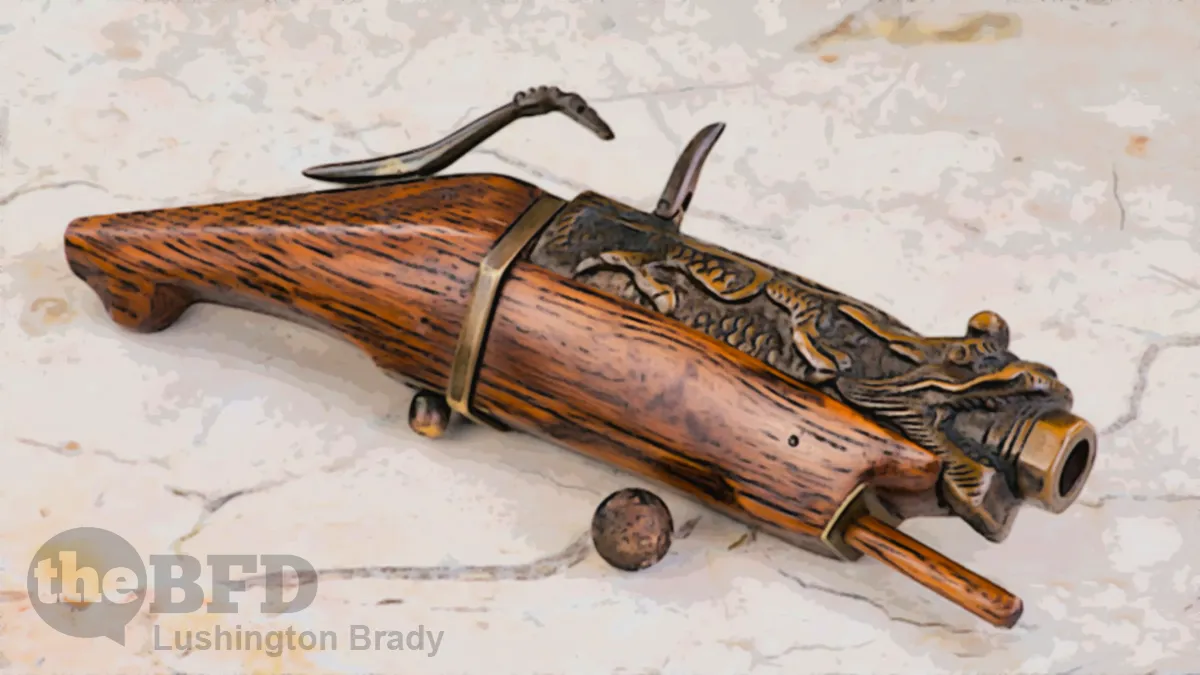Table of Contents
In human history, a handful of technologies have changed everything. Fire, for instance, and agriculture. Writing. The wheel. In the last few centuries, though, one technology upended global balances of power. As hinted in Jared Diamond’s Guns, Germs and Steel, that technology was the firearm.
Who had projectile weapons, and who didn’t, could alter the course of civilisations.
Of course, firearms weren’t the first projectile weapons. Slings and bows long preceded gunpowder. Even superior bows, such as the Mongol compound recurve bow or the English longbow, brought tremendous battlefield advantages. But gunpowder outdid them all. Access to firearms by some tribes prompted the devastating New Zealand Musket Wars.
But it was a long way from ninth-century China, where gunpowder was invented, to 19th-century British muskets. Ironically, perhaps, it is believed that Chinese alchemists accidentally discovered gunpowder while trying various mixtures to make an “elixir of life”.
It was a century and more from the invention of gunpowder to the first firearm. The “fire lance” was a black powder tube fixed to the end of a spear. Rather than a true projectile weapon, it was mostly used as a kind of flamethrower, although sometimes shrapnel was packed into the tube. By the 13th century, the Chinese had developed iron-casing bombs and proto-cannons.
Within the next century, the firearm had spread to Muslim armies. It is believed that the Mamluks used the first true cannons against the Mongols and the musket appeared in the arsenal of the Ottoman armies by the late 15th century. The state-controlled manufacture of gunpowder by the Ottoman Empire contributed significantly to its expansion between the 15th and 18th centuries.
Meanwhile, gunpowder reached Europe in the 13th century. How it got there is disputed: some attribute it to Silk Road trade, while others argue that it arrived with the Mongol invaders.
However it arrived, gunpowder was made at the Tower of London by 1346.
There are also sources about the kingdom of England using some types of cannons in the 1340s. Other sources show up in Russia about firearms being used against the Mongols in Moscow 1382. Muscovites used firearms called “tyufyaki” which is translated to “gun”.
In the 14th century, Italy developed hand-held cannons or as they are called Schioppo. The Ottomans started using firearms in their army in the same time.
In 14th-century India, as well, gunpowder was widely used. The Mughals used mass-produced matchlock rifles in the 16th century. The Mughals also used sappers equipped with gunpowder charges to breach walls, as well as using rockets for signalling and against massed infantry forces.
The modern age where many discoveries were made had a huge impact on firearms. During the early modern age, the “gun” was reformed, it was evolved into the famous flintlock rifle that could be seen here […]
Then it evolved again. Breech-loading weapon were discovered and showed a huge effect on the battlefield.
As early as 1500, the Spanish Empire equipped its soldiers with arquebusiers.
They were accurate handguns that were light and portable.
People with low equipment could carry and use them and no armor was needed. They started dominating on the battlefield against the other armies that were mainly knights. The first battle that was ever won with firearms was in 1530 by the Spanish army in the Battle of Cerignola.
But the weapons weren’t fast at all, they take very long in order to be reloaded and also took a lot of time to be fired.
Hence the appearance of the bayonet. Instead of being rendered helpless while trying to reload, soldiers could revert to old-fashioned hand-to-hand fighting. Even as late as the early 20th century, the bayonet, or more often, weapons improvised from trenching tools, were widely used on the Western Front.
But fast-loading rifles and machine guns changed everything.
A lot changed with the Springfield rifle. They were one of the best breech-loading rifles that were produced in the 1860s in the US. As time passed by firearms became more accurate, effective, fast, and deadly.
About History
In early Western Front battles, British Regulars with bolt-action Lee-Enfield 303s could fire so rapidly that opposing Germans were convinced that they were facing machine-gun fire. Key to this was the Lee-Enfield’s bolt mechanism that operated to the side of the rifle. By contrast, German Mausers had the bolt facing upright on the breech, meaning that soldiers risked punching themselves in the face every time they reloaded.
Multi-round rifles were invented as early as the 14th century. These were mostly cumbersome affairs with multiple barrels. The Puckle gun of the early 18th century had a revolving flintlock chamber, but it was never mass-produced or actually used in combat.
The Gatling gun (1861) was hand-cranked and fed from a hopper, but its crank mechanism means that it was not a true machine-gun. That honour belongs to the belt-fed Maxim gun, invented in 1884.
Both Richard Gatling and Hiram Maxim believed their inventions were essentially “peace makers”. Gatling, who’d witnessed the mass slaughter of the Civil War, believed his gun would reduce battlefield deaths. The Gatling gun, he thought, made the need for large armies obsolete. Smaller armies = few casualties.
Regarding the Maxim gun, the New York Times opined, “These are the instruments that have revolutionized the methods of warfare and, because of their devastating effects, have made nations and rulers give greater thought to the outcome of war before entering… They are peace-producing and peace-retaining terrors.”
We can safely judge that both inventors were wrong.








